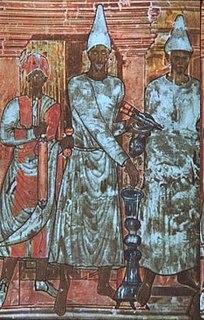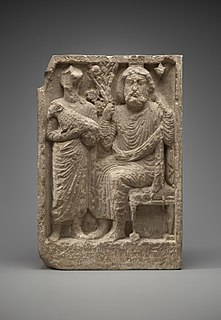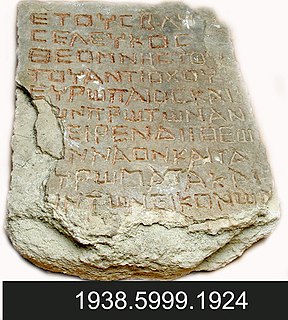
Mithraism, also known as the Mithraic mysteries, was a Roman mystery religion centered on the god Mithras. Although inspired by Iranian worship of the Zoroastrian divinity (yazata) Mithra, the Roman Mithras is linked to a new and distinctive imagery, with the level of continuity between Persian and Greco-Roman practice debated. The mysteries were popular among the Imperial Roman army from about the 1st to the 4th century CE.

Dura-Europos, also spelled Dura-Europus, was a Hellenistic, Parthian and Roman border city built on an escarpment 90 metres above the southwestern bank of the Euphrates river. It is located near the village of Salhiyé, in today's Syria. In 113 BC, Parthians conquered the city, and held it, with one brief Roman intermission, until 165 AD. Under Parthian rule, it became an important provincial administrative centre. The Romans decisively captured Dura-Europos in 165 AD and greatly enlarged it as their easternmost stronghold in Mesopotamia, until it was captured by the Sasanian Empire after a siege in 256–57 AD. Its population was deported, and after it was abandoned, it was covered by sand and mud and disappeared from sight.

The London Mithraeum, also known as the Temple of Mithras, Walbrook, is a Roman mithraeum that was discovered in Walbrook, a street in the City of London, during a building's construction in 1954. The entire site was relocated to permit continued construction and this temple of the mystery god Mithras became perhaps the most famous 20th-century Roman discovery in London.

The Dura-Europos synagogue was an ancient synagogue uncovered at Dura-Europos, Syria, in 1932. The synagogue contains a forecourt and house of assembly with painted walls depicting people and animals, and a Torah shrine in the western wall facing Jerusalem. It was built backing on to the city wall, which was important in its survival. The last phase of construction was dated by an Aramaic inscription to 244 AD, making it one of the oldest synagogues in the world. It was unique among the many ancient synagogues that have emerged from archaeological digs as the structure was preserved virtually intact, and it had extensive figurative wall-paintings, which came as a considerable surprise to scholars. These paintings are now displayed in the National Museum of Damascus.

Tauroctony is a modern name given to the central cult reliefs of the Roman Mithraic Mysteries. The imagery depicts Mithras killing a bull, hence the name tauroctony after the Greek word tauroktonos. A tauroctony is distinct from the sacrifice of a bull in ancient Rome called a taurobolium; the taurobolium was mainly part of the unrelated cult of Cybele.

Cautes and Cautopates are torch-bearers depicted attending the god Mithras in the icons of the ancient Roman cult of Mithraism, known as Tauroctony. Cautes holds his torch raised up, and Cautopates holds his torch pointed downward.
The Roman cult of Mithras had connections with other pagan deities, syncretism being a prominent feature of Roman paganism. Almost all Mithraea contain statues dedicated to gods of other cults, and it is common to find inscriptions dedicated to Mithras in other sanctuaries, especially those of Jupiter Dolichenus. Mithraism was not an alternative to other pagan religions, but rather a particular way of practising pagan worship; and many Mithraic initiates can also be found worshipping in the civic religion, and as initiates of other mystery cults.

Parthian art was Iranian art made during the Parthian Empire from 247 BC to 224 AD, based in the Near East. It has a mixture of Persian and Hellenistic influences. For some time after the period of the Parthian Empire, art in its styles continued for some time. A typical feature of Parthian art is the frontality of the people shown. Even in narrative representations, the actors do not look at the object of their action, but at the viewer. These are features that anticipate the art of medieval Europe and Byzantium.

Yarhibol or Iarhibol is an Aramean god who was worshiped mainly in ancient Palmyra, a city in central Syria. He was depicted with a solar nimbus and styled "lord of the spring". He normally appears alongside Bel, who was a co-supreme god of Palmyra, and Aglibol, one of the other top Palmyrene gods.

The Temple of the Gadde is a double temple in the Syrian city of Dura-Europos, located near the agora. It was dedicated to the protective deities Gaddē of Dura-Europos and the nearby city of Palmyra. It was excavated between 1934 and January 1936 by the French/American expedition of Yale University, led by Michael Rostovtzeff.

The Temple of Bel, also known as the Temple of the Palmyrene gods, was located in Dura Europos, an ancient city on the Euphrates, in modern Syria. The temple was established in the first century BC and is celebrated primarily for its wall paintings. Despite the modern names of the structure, it is uncertain which gods were worshipped in the structure. Under Roman rule, the temple was dedicated to the Emperor Alexander Severus. In that period, the temple was located within the military camp of the XXth Palmyrene cohort.

The Temple of Zeus Kyrios stood in the city of Dura-Europos (Syria) and was probably built in the first century BC. It was excavated in 1934 by a joint French-American expedition.

The Temple of Zeus Theos at Dura Europos was built in the second century AD and was among the most important sanctuaries of the city. The structure was located in the centre of the settlement. It had an area of around 37 m2 and took up half an insula. It was excavated by an American-French team between December 1933 and March 1939.

The Temple of Adonis in Dura-Europos was discovered by a French-American expedition of Yale University led by Michael Rostovtzeff and was excavated between 1931 and 1934.

The Statue of Hercules was discovered in the Temple of Zeus Megistos in Dura-Europos during the 1935–1937 excavations undertaken by Yale University and the French Academy. The statue dates from the period of Roman rule at Dura-Europos. It is now in the possession of the Yale Art Gallery.
Mithraeum in Hawarte – a sanctuary of the Persian god Mithra, discovered under the basilica of Archbishop Photios in Hawarte, Syria, near Apamea.

The scutum from Dura Europos is the only surviving semicylindrical shield, scutum, from Roman times. It is now in the Yale University Art Gallery. The shield was found in the excavation campaign of 1928/37 on Tower 19 of Dura Europos. The city was besieged by the Sassanids in 256, eventually captured and destroyed. The dry climate enables very good conservation conditions for organic materials such as wood. Since the city housed a Roman garrison and was lost during a siege, a particularly large number of weapons were found during the excavations.

The so-called Dolicheneum is a temple in Dura Europos in the east of today's Syria, where Jupiter Dolichenus and god called Zeus Helios Mithras Turmasgade may have been worshiped. The remains of the temple were excavated in 1935/36, but results were never fully published.
The so-called necropolis temple of Dura Europos was in the north of the city, outside the city walls, about 150 m northwest of the main gate.

Sanctuary of Aphlad is located in the south-west of Dura Europos. It is the sanctuary of Aphlad, god of the city of Anath on the Euphrates, built by 54 CE.























